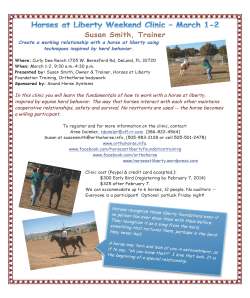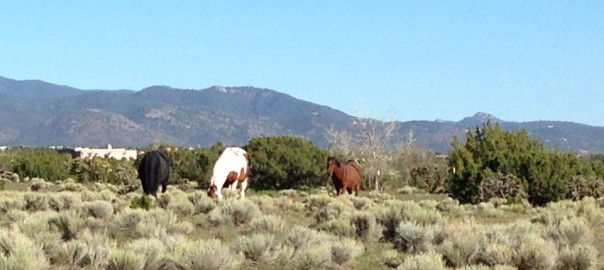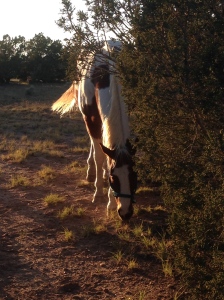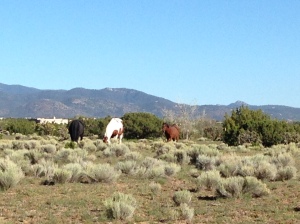How deep does your horsemanship go?
I began to ask this question of myself this week. The reason why I asked it was I was thinking about whether there was a measuring stick for that depth. But more importantly, as I think it takes time to develop, how do you develop it?
I was reminded recently of getting to see and hear Jane Goodall speak years ago at a conference in San Diego. Her life has been devoted to the study of chimpanzees, but also has extended to the protection of other endangered species. When she was 23, Jane left England for what is now known as Tanzania. She sat day after day with the chimps, with only her notebook and a pair of binoculars, and ultimately won their trust so they would come closer. She was able to research their habits first hand. She learned about their emotions, their personalities, their likes and dislikes, and one of the facts that was groundbreaking for science: they used tools. They stripped the leaves off twigs to fish termites out of a mound.
What Jane did with chimps is what we can do with horses, sit with our notebook or a book, and find out who they are. With chimps, I’m not sure they really wanted anything from Jane, but they were curious. We don’t need the binoculars since most of the time the horses will end up pretty close up, unless we are sitting with a wild herd. Horsemanship, like “chimpmanship” can deepen by finding out what they want from us, how to establish firm and fair boundaries, and how to make that relationship “right.”
By moving away from the task-oriented approach to horses to an observant member of the herd, more trust can be developed that can later be useful when you need to ask for something. While horses are far more domesticated than chimps, unless they are wild horses, of course, they still have a lot of wildness and maintain their own rhythms.
Some things I have noticed while just being with my horses:
One horse wants to stay out and just be with me. Because I’m a human I don’t have all the time in the world. The time I spend with him makes him a better horse, calmer, easier in his being. Of all my horses, he is the one who is most conscious of the amount of time I spend with him. The others do not count the hours as he does. Maybe it’s because he’s a different color than they are, who knows. If I spend three hours with him, he will not want to go back to his corral. He might be completely satisfied with the interaction but as far as he is concerned, I should move into the three-sided shelter and big corral and live with him forever. I have to keep in mind where he came from and why this is so important to him, and do what I can for him.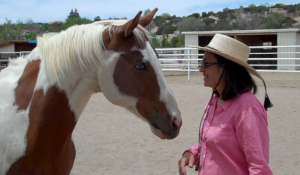
My older mare will make it clear that she wants to stand with me. Our gelding will sometimes think he needs to manage this situation and push her away. She will persist and keep coming back. Once when I was standing with her while she was eating, he came over and I was between the two horses. She moved away so she was on the outside, and I wasn’t between them. She then moved so that I was on the outside of her, so that if he suddenly decided to move her, I would be on the outside and could move out of the way. It was amazing, her concern for my safety, coupled with her desire to be next to me. And her global knowledge: where he was, what he might do, what he wants.
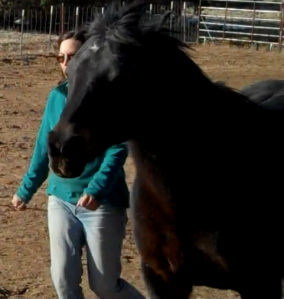 She is far more tuned in to how much space is between us, what is comfortable, than he is. Although he is an older horse, he really needs frequent reminders through the “Walking a horse down” exercise, because he is so used to moving her and others. Those who are used to managing need to be managed so that they can relax. Like on a trail ride – the horse in front is watchful all the time, ears forward. The horse behind is much more relaxed. Change places and watch the demeanor of the horse in front now, and the horse behind. Watch the ears. Feel their respiration change and the tension drop from their bodies.
She is far more tuned in to how much space is between us, what is comfortable, than he is. Although he is an older horse, he really needs frequent reminders through the “Walking a horse down” exercise, because he is so used to moving her and others. Those who are used to managing need to be managed so that they can relax. Like on a trail ride – the horse in front is watchful all the time, ears forward. The horse behind is much more relaxed. Change places and watch the demeanor of the horse in front now, and the horse behind. Watch the ears. Feel their respiration change and the tension drop from their bodies.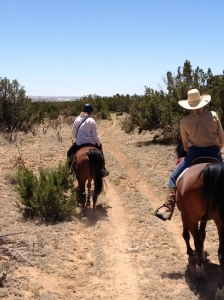
Switching roles is something they do in the wild. This distributes responsibility more evenly, although those who are not responsible yet won’t be given this responsibility. This helps establish and hold boundaries, and keeps everyone safe.
There is a place of boundaries that we must all cultivate with horses. This is something they expect because it’s how they live. If we allow them to just eat treats and run all over us, we won’t be safe and they won’t respect us, and amazingly, they won’t be happy!
In traditional horse training, it is all about what the horse can do for you. Economics. In my coaching, it is about what we can do for the horse.
Because once again, I don’t have all the time in the world and that time I do have has to be spread out over all loved ones, so I look deeply at my horsemanship and what each needs in that moment, in that day. I find that creating the boundary, in words or intention, helps the horse know how long I’ll be there with him and what we will do together. I try to spend alone time with each horse at least once a week. He gets to have a say in what we do. But some times, I need to direct the activity more.
For example, if my horse has been especially pushy, then he is going to need a particular exercise that day, probably not the one he would have chosen for himself. It’s up to me to be creative. After the activity is introduced, he will relax and a shift will occur. He will get into the activity and make it his own. If I have chosen incorrectly and it doesn’t work, then I have to pick something else.
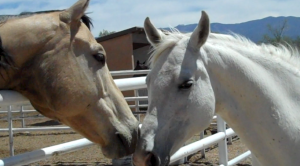
Some of these things are not new, are used by trainers everywhere, but they come with a different perspective. It is not: now I’ll show you who’s boss. It is more like: now we will work with some of those things you had trouble with. The energy and intention behind the activity demonstrates a depth of horsemanship that our horses help teach us if we are willing to listen.
Some days I can’t wait to get out there with the horses and find out what I’m going to learn that day. I look forward to their eagerness to do something new or even to revisit something we’ve done before, but they may wish to do differently. Or even do nothing at all. Because they are masters of subtlety, they find that in me, they teach me to see and to then deepen my horsemanship in new ways.
So how deep is your horsemanship? I invite you to ask that question and explore it to see what you find out, and what the horses will show you.
****
(copyright: Susan Smith, OrthoHorse)
Services: Bodywork (Ortho-Bionomy for people, Equine Positional Release/Equine Ortho-Bionomy): private sessions, tutorials, phone consultations, distance healing communication and gift certificates
Liberty Coaching: clinics, mini-clinics, workshops, private and semi-private sessions, tutorials, consultations: by appointment: 505.501.2478 or emailing susansmith@orthohorse.info Winter Lessons – semi-private, private and small group sessions. Scheduling now. Contact me for details.
New on the schedule for 2014:
February 8, OrthoHorse Tutorial — Arrowhead Ranch, Santa Fe, Susan Smith, Advanced Registered Practitioner Ortho-Bionomy 9:30 a.m.-12:30 p.m. If this one fills up we may open an afternoon session.
March 1-2 Horses at Liberty Foundation Training Weekend Clinic, DeLand, Florida. Early Bird Deadline for Discount: February 7th! Book your spot today! Contact Anne Daimler, tdaimler@cfl.rr.com (386-822-4564) or myself for registration and information. Space is limited. OrthoHorse Tutorial also offered before the clinic: February 28 (see flyers below).An afternoon Tutorial may be offered by popular demand. Private bodywork sessions and lessons are being scheduled now.
April 5-6 Spirit Horse Ranch Liberty Foundations Clinic, Jones Oklahoma, Presented by coaches Ruella Yates and Susan Smith. Contact Ruella Yates ruella@libertyfoundations.com, (405-771-4274) or myself for registration and information. Space is limited. Private bodywork sessions and lessons are being scheduled now.